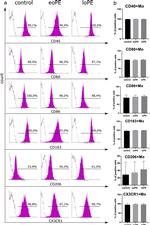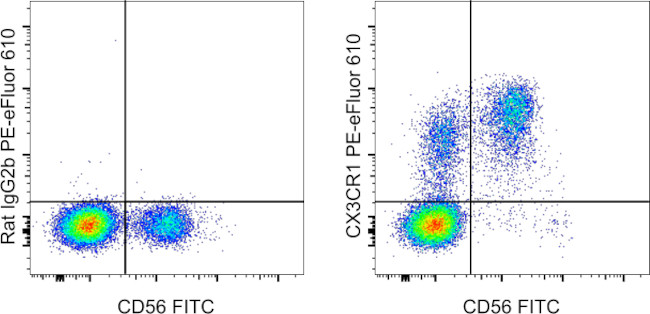Search Thermo Fisher Scientific
Invitrogen
CX3CR1 Monoclonal Antibody (2A9-1), PE-eFluor™ 610, eBioscience™
FIGURE: 1 / 2
CX3CR1 Antibody (61-6099-42) in Flow


Product Details
61-6099-42
Species Reactivity
Published species
Host/Isotype
Recommended Isotype Control
Class
Type
Clone
Conjugate
Excitation/Emission Max
Form
Concentration
Purification
Storage buffer
Contains
Storage conditions
Shipping conditions
RRID
Product Specific Information
Description: This 2A9-1 monoclonal antibody reacts with human CX3CR1, which is the receptor for fractalkine, a transmembrane chemokine of the CX3C family. CX3CR1 is a seven transmembrane G protein-coupled receptor expressed on CD16+ NK cells, T cells (e.g. CD8+, CD4+, and gamma/delta), and monocytes. In non-immune cells, CX3CR1 has been found on osteoclast precursors and microglia. Little to no CX3CR1 surface expression can be detected on B cells and granulocytes. Together, fractalkine and its receptor mediate cell-cell adhesion and chemotaxis of NK cells, T cells, and monocytes. The expression of CX3CR1 has also been correlated with high levels of intracellular perforin and granzyme B.
Applications Reported: This 2A9-1 antibody has been reported for use in flow cytometric analysis.
Applications Tested: This 2A9-1 antibody has been pre-diluted and tested by flow cytometric analysis of normal human peripheral blood cells. This may be used at 5 µL (0.125 µg) per test. A test is defined as the amount (µg) of antibody that will stain a cell sample in a final volume of 100 µL. Cell number should be determined empirically but can range from 10^5 to 10^8 cells/test.
PE-eFluor 610 can be excited with laser lines from 488-561 nm and emits at 607 nm. We recommend using a 610/20 band pass filter (equivalent to PE-Texas Red). Please make sure that your instrument is capable of detecting this fluorochrome.
Light sensitivity: This tandem dye is sensitive to photo-induced oxidation. Please protect this vial and stained samples from light.
Fixation: Samples can be stored in IC Fixation Buffer (Product # 00-8222-49) (100 µL of cell sample + 100 µL of IC Fixation Buffer) or 1-step Fix/Lyse Solution (Product # 00-5333-57) for up to 3 days in the dark at 4°C with minimal impact on brightness and FRET efficiency/compensation. Some generalizations regarding fluorophore performance after fixation can be made, but clone specific performance should be determined empirically.
Excitation: 488-561 nm; Emission: 607 nm; Laser: Blue Laser, Green Laser, Yellow-Green Laser.
Target Information
CX3CR1 is one of the chemokine receptors that are required as coreceptors for HIV infection. The genes encoding human, mouse, and rat CX3CR1 were cloned and designated V28 and CMKBRL1, CX3CR1, and RBS11, respectively. The encoded seven transmembrane protein was recently identified as the receptor for a novel transmembrane molecule, fractalkine, and renamed CX3CR1. Recently, CX3CR1 was found to serve as a coreceptor for HIV-1 and HIV-2 envelope fusion and virus infection, which can be inhibited by fractokine. CX3CR1 mediates leukocyte migration an d adhesion. CX3CR1 is expressed in a variety of human tissues and cell lines.
For Research Use Only. Not for use in diagnostic procedures. Not for resale without express authorization.
How to use the Panel Builder
Watch the video to learn how to use the Invitrogen Flow Cytometry Panel Builder to build your next flow cytometry panel in 5 easy steps.
Bioinformatics
Protein Aliases: Beta chemokine receptor-like 1; C-X3-C CKR-1; chemokine (C-C) receptor-like 1; chemokine (C-X3-C motif) receptor 1; chemokine (C-X3-C) receptor 1; CMK-BRL-1; CMK-BRL1; Cx3c; CX3C chemokine receptor 1; Fractalkine receptor; G protein-coupled receptor 13; G-protein coupled receptor 13; Scyd1; V28
Gene Aliases: CCRL1; CMKBRL1; CMKDR1; CX3CR1; GPR13; GPRV28; V28
UniProt ID: (Human) P49238
Entrez Gene ID: (Human) 1524

Performance Guarantee
If an Invitrogen™ antibody doesn't perform as described on our website or datasheet,we'll replace the product at no cost to you, or provide you with a credit for a future purchase.*
Learn more
We're here to help
Get expert recommendations for common problems or connect directly with an on staff expert for technical assistance related to applications, equipment and general product use.
Contact tech support

